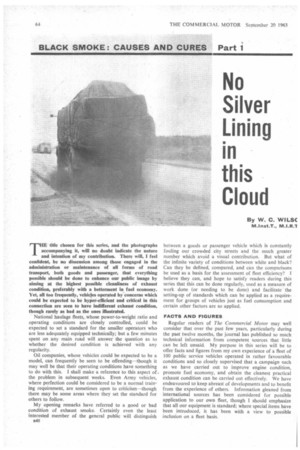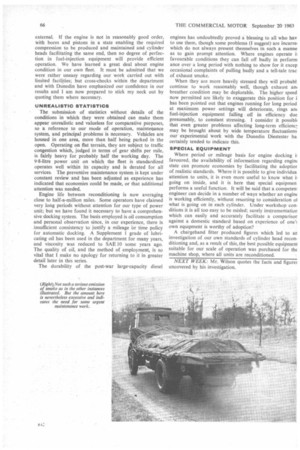No Silver Lining in this Cloud
Page 66

Page 67

Page 68

If you've noticed an error in this article please click here to report it so we can fix it.
By W. C. WILSC M.Inst.T., THE title chosen for this series, and the photographs accompanying it, will no doubt indicate the nature and intention of my contribution. There will, I feel confident, be no dissension among those engaged in the administration or maintenance of all forms of road transport, both goods and passenger, that everything possible should be done to enhance our public image by aiming at the highest possible cleanliness of exhaust condition, preferably with a betterment in fuel economy. Yet, all too frequently, vehiqes operated by concerns which could be expected to be hyper-efficient and critical in this connection are seen to have indifferent exhaust condition, though rarely as bad as the ones illustrated.
National haulage fleets, whose power-to-weight ratio and operating conditions are closely controlled, could be expected to set a standard for the smaller operators who are less adequately equipped technically; but a few minutes spent on any main road will answer the question as to whether the desired condition is achieved with any regularity.
Oil companies, whose vehicles could be expected to be a model, can frequently be seen to be offending—though it may well be that their operating conditions have something to do with this. I shall make a reference to this aspect of. the problem in subsequent weeks. Even Army vehicles, where perfection could be considered to be a normal training requirement, are sometimes open to criticism—though there may be some areas where they set the standard for others to follow.
My opening remarks have referred to a good or bad condition of exhaust smoke. Certainly even the least interested member of the general public will distinguish B40 between a goods or passenger vehicle which is constantly fouling our crowded city streets and the much greater number which avoid a visual contribution. But what of the infinite variety of conditions between white and black? Can they be defined, compared, and can the comparisons be used as a basis for the assessment of fleet efficiency? believe they can, and hope to satisfy readers during this series that this can be done regularly, used as a measure of work done (or needing to be done) and facilitate the setting-up of standards which can be applied as a requirement for groups of vehicles just as fuel consumption and certain other factors are so applied.
FACTS AND FIGURES
Regular readers of The Commercial Motor may well consider that over the past few years, particularly during the past twelve months, the journal has published so much technical information from competent sources that little can be left unsaid. My purpose in this series will be to offer facts and figures from my own experience of a fleet of 100 public service vehicles operated in rather favourable conditions and so closely supervised that a campaign such as we have carried out to improve engine condition, promote fuel economy, and obtain the cleanest practical exhaust condition can be carried out effectively. We have endeavoured to keep abreast of developments and to benefit from the experience of others. Information gleaned from international sources has been considered for possible application to our own fleet, though I should emphasize that all our equipment is standard; where special items have been introduced, it has been with a view to possible inclusion on a fleet basis. low serious a problem is the question of exhaust What is the possible effect on public health? How ) we need to concern ourselves regarding avoidance, ;don, and what will happen if we do nothing? In .rms, it has been estimated that in 10 years there LI be three times as many vehicles on the road as at so obviously it is going to need quite a blitz (as ister of Transport once remarked) to avoid a serious Won in atmospheric conditions in city streets_ recently, due to a strategic error, I was passing London's BlackwaIl Tunnel at noon on a summer took half an hour to pass through the tunnel and no doubt, the ventilating system was working the air was so polluted that much of the holiday ith which I entered the tunnel had evaporated by [left it.
traffic, particularly' in the larger cities, must surely 3wer traffic, more time to discharge fumes, and also told) always more people to breathe them in and • percentage of old people on whom the effects are o prove more serious. Much of the criticism particularly against the diesel engine, has been rned and alarmist. It is possible, by a suitable of opinion, to aggravate or whitewash the i; but, though the harshest criticism is excessive, blem does justify serious concern and energetic I. measures.
THING IS DONE...
Thing is done, public opinion and Government vill ensure in the not-too-distant future that action against the most flagrant offenders. It should be appreciated in this connection that, as the efforts made by the conscientious take effect, the vehicles operated by the more casual will be highlighted, even where they are not particularly noticeable today.
Those who have set themselves the highest possible standard in regard to cleanliness will, I believe, have found with most engines that it is difficult to avoid a visual degree of black exhaust on a routine fleet basis. This has certainly been our experience; the blitz carried out on our own fleet was intended to put things right once and for all, to aim at being " whiter than white ", with the hope that the cost would be defrayed by fuel economy. A considerable degree of success has been achieved, but we now appreciate that it is like painting the Forth Bridge—by the time you get to one end it's time to start on the other!
NEED FOR STANDARDS
There is a need to set up standards which can be achieved on a fleet basis for exhaust condition and for the factors which influence that condition (engine compression, cylinder head condition, the efficiency of fuel-injection equipment, and so on). It is also necessary to have a method of measurement for the principal factors applicable. 1' am satisfied that, in my fleet, we found a reasonable answer within the skill and purse of even the smaller operators in three items of equipment marketed by the Dunedin Engineering Co. Ltd., and I shall detail our findings next week.
Engine condition must necessarily play a vital part in the nature of the products of combustion passed into the exhaust system and also, for that matter, vented to atmosphere through the breather—where sump venting is external, if the engine is not in reasonably good order, with bores and pistons in a state enabling the required compression to be produced and maintained and cylinder heads facilitating the same end, then no degree of perfection in fuel-injection equipment will provide efficient operation. We have learned a great deal about engine condition in our own fleet. It must be admitted that we were rather uneasy regarding our work carried out with limited facilities; but cross-checks within the department and with Dunedin have emphasized our confidence in our results and I am now prepared to stick my neck out by quoting them where necessary.
UNREALISTIC STATISTICS
The submission of statistics without details of the conditions in which they were obtained can make them appear unrealistic and valueless for comparative purposes, so a reference to our mode of operation, maintenance system, and principal problems is necessary. Vehicles are housed in one area, more than half being parked in the open. Operating on flat terrain, they are subject to traffic congestion which, judged in terms of gear shifts per mile, is fairly heavy for probably half the working day. The 9.8-litre power unit on which the fleet is standardized operates well within its capacity and is derated for all services. The preventive maintenance system is kept under constant review and has been adjusted as experience has indicated that economies could be made, or that additional attention was needed.
Engine life between reconditioning is now averaging close to half-a-million miles. Some operators have claimed very long periods without attention for our type of power unit; but we have found it necessary to have a comprehensive docking system. The basis employed is oil consumption and personal observation since, in our experience, there is insufficient consistency to justify a mileage br time policy for automatic docking. A Supplement 1 grade of lubricating oil has been used in the department for many years, and viscosity was reduced to SAE 10 some years ago. The quality of oil, and the method of employment, is so vital that I make no apology for returning to it in greater detail later in this series.
The durability of the post-war large-capacity diesel engines has undoubtedly proved a blessing to all who hay to use them, though some problems (I suggest) are incurre. which do not always present themselves in such a manne as to gain prompt attention. Where engines operate i favourable conditions they can fall off badly in perform ance over a long period with nothing to show for it excep occasional complaints of pulling badly and a tell-tale trac of exhaust smoke.
When they are more heavily stressed they will probabl continue to work reasonably well, though exhaust an breather condition may be deplorable. The higher speed now permitted are likely to exaggerate this position for i has been pointed out that engines running for long period at maximum power settings will deteriorate, rings am fuel-injection equipment falling off in efficiency due presumably, to constant stressing. I consider it possibli that even greater problems affecting long-term etlicienc! may be brought about by wide temperature fluctuations our experimental work with the Dunedin Diestester ha certainly tended to indicate this.
SPECIAL EQUIPMENT
Where period or mileage basis for engine docking favoured, the availability of information regarding engint state can promote economies by facilitating the adoptior of realistic standards. Where it is possible to give individua attention to units, it is even more useful to know what i! going on inside, and it is here that special equipmen performs a useful function. It will be said that a competem engineer can decide in a number of ways whether an engin< is working efficiently, without resorting to consideration of what is going on in each cylinder. Under workshop con. ditions it is all too easy to be misled; surely instrumentatior which can easily and accurately facilitate a comparisor against a domestic standard based on experience of one' own equipment is worthy of adoption?
A chargehand fitter produced figures which led to ar investigation of our own standards of cylinder head recon. ditioning and, as a result of this, the best possible equipment suitable for our scale of operation was purchased for the machine shop, where all units are reconditioned.
NEXT WEEK: Mr. Wilson quotes the facts and figures uncovered by his investigation.




















































































































